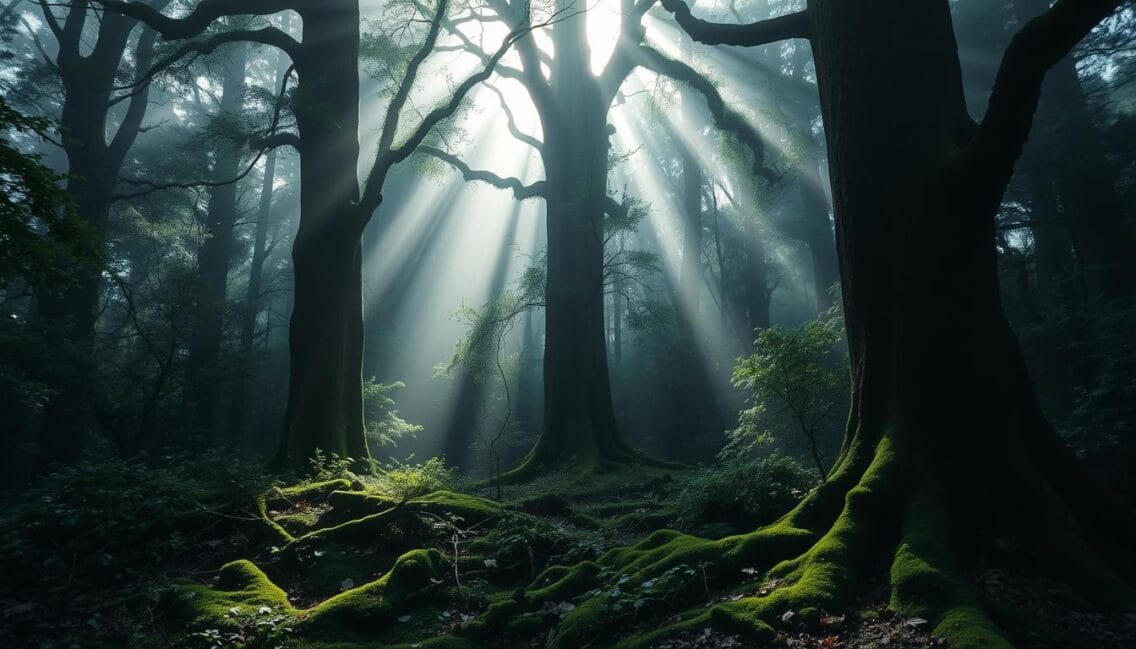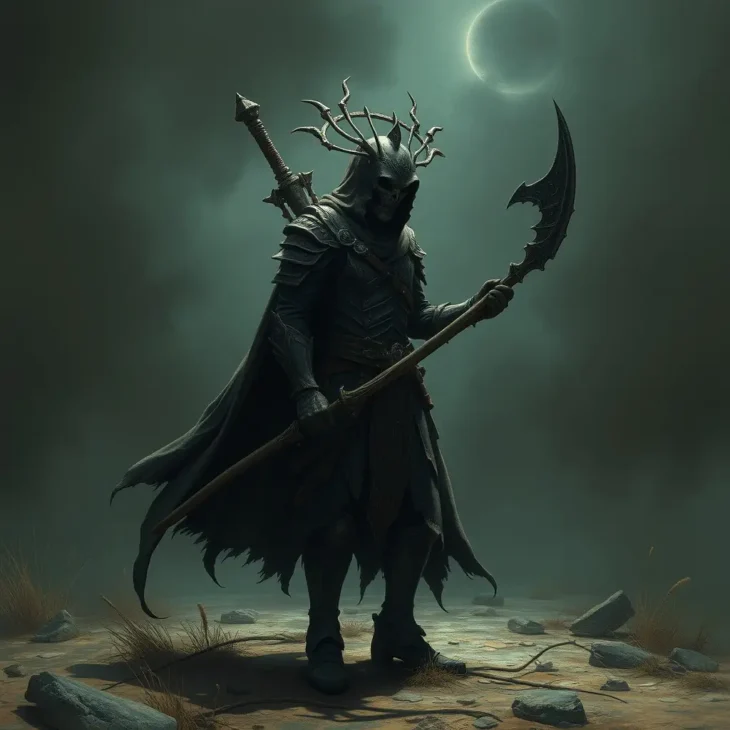The Onryo of Aokigahara Forest

Exploring Japan’s mysteries, I find myself drawn to Aokigahara Forest, also called the Suicide Forest. It’s a vast woodland near Mount Fuji, known for tragic losses and vengeful spirits called onryō. The Japanese believe that violent or unexpected deaths can turn into yūrei, or ghosts. The most evil are the onryō, spirits that seek to harm the living.
The forest’s dense, eerie atmosphere is unsettling. The sounds are muffled, and your breathing seems louder, making it feel trapped. This place became infamous after Seichō Matsumoto’s 1960 novel “Kuroi Jukai” (Black Sea of Trees) highlighted its dark allure. To combat the suicides, the Japanese government has posted helpline numbers and conducts searches with volunteers.
Key Takeaways
- Aokigahara Forest, near Mount Fuji, is known as the “Suicide Forest” due to the high number of suicides that occur there each year.
- The forest’s eerie and claustrophobic atmosphere, with muffled sounds and one’s own amplified breathing, contributes to its haunting reputation.
- The forest’s modern notoriety as a suicide site began with the 1960 novel “Kuroi Jukai” (Black Sea of Trees) by Seichō Matsumoto.
- The Japanese government has attempted to address the issue, posting helpline numbers and conducting body searches with volunteers.
- The forest’s association with vengeful spirits, known as onryō, adds to the sense of supernatural danger and mystery.
Understanding the Nature of Onryo in Japanese Folklore
In Japanese folklore, the Onryo is a powerful figure. It’s a vengeful spirit that can harm the living. These spirits come from souls filled with anger and a desire for revenge. The first Onryo was Prince Nagaya in 729 AD.
The Transformation from Reikon to Vengeful Spirit
Onryo are usually wronged women. Their anger and sadness make them haunt the living. They can cause disasters, deaths, and other bad things. Their power shows how deep human emotions can be.
Historical Origins and Cultural Significance
The Onryo have fascinated Japan for centuries. They’ve left a lasting impact on stories, art, and culture. Classics like “The Tale of Genji” and “Yotsuya Kaidan” feature them. They also appear in traditional arts like Noh, Kabuki, and Rakugo.
Types of Spiritual Manifestations
Onryo are seen as pale, ghostly figures with long hair and tattered white robes. Their eerie sounds and sudden appearances have made them famous in horror stories. They can possess people, disturb places, and even cause death.
“The Onryo’s wrath stems from emotions like anger, despair, or betrayal, which power their haunting manifestations.”
Aokigahara Forest: The Sea of Trees at Mount Fuji
The Aokigahara Forest, or “Sea of Trees,” is at Mount Fuji’s base. It covers 30 square kilometers of hardened lava from 864 CE. This place is both beautiful and tragic, attracting many visitors and ghost story fans.
The forest is known for its death and supernatural ties. In 2003, 105 bodies were found here, a record. The Japanese government stopped sharing suicide numbers in 2010. Yet, the forest’s dark reputation persists, with a spike in attempts in March.
Despite its dark past, Aokigahara is a favorite for hikers. It’s home to many plants and animals, like black bears and red foxes. There’s an eight-mile trail system, but some areas are off-limits to respect the dead.
Aokigahara’s mystery has made it famous worldwide. It’s a natural wonder and a place of deep tragedy. This “Sea of Trees” at Mount Fuji’s base is a place of wonder and sadness for all who explore it.
The Japanese Ghost Legend of the Three Great Onryo
In Japanese folklore, the Three Great Onryo, or vengeful spirits, are well-known. They are believed to be the spirits of those who died with unfinished business. These spirits have deeply influenced Japanese culture.
Emperor Sutoku’s Vengeful Legacy
Emperor Sutoku is one of the most famous of the Three Great Onryo. He died in the 12th century and became a vengeful ghost. His spirit is said to have caused many natural disasters and political troubles in Japan.
Taira no Masakado’s Enduring Influence
Taira no Masakado was a powerful samurai whose head was put on a spike in Tokyo. His spirit is believed to haunt the city. His head mound is kept today to avoid his wrath.
Sugawara no Michizane’s Transformation into Tenjin
Sugawara no Michizane was a scholar and statesman who was exiled and died in shame. But his spirit was later honored as Tenjin, the kami of scholarship. It’s said he caused lightning strikes and deaths among his enemies.
These Japanese ghost legends show the strong belief in vengeful spirits in Japan. They have a lasting impact on the country’s culture.
“The spirits of the dead have a power that the living cannot comprehend. They are forces to be reckoned with, not trifled with.”
Supernatural Phenomena and Hauntings in Aokigahara
Aokigahara Forest lies at Mount Fuji’s base in Japan. It’s known as the “Suicide Forest” for its dark past. Visitors and researchers are drawn to its mysteries, like unexplained noises and ghostly apparitions.
The forest’s soil is rich in iron, causing gadgets to fail. This adds to the eerie feeling. It’s hard to navigate the dense forest and find your way out.
“The temperature in the forest can drop significantly, reaching as low as 17 degrees Fahrenheit in mid-January. This extreme chill, coupled with the dense vegetation and lack of reliable navigation, can create an unsettling atmosphere for those who venture into the Japan’s supernatural realm.”
People talk about yūrei spirits in the forest. They say bloodcurdling screams echo through the trees. The forest’s reputation for Aokigahara hauntings and supernatural phenomena in Japan has grown.
Despite its eerie feel, Aokigahara Forest fascinates many. Researchers and paranormal fans keep exploring its mysteries. The forest’s secrets continue to capture the imagination of all who venture there.
Cultural Impact and Modern Interpretations
The Japanese onryo, or vengeful spirits, have made a lasting impact on popular culture. They appear in movies and books, captivating people in Japan and globally. Sadako Yamamura from “The Ring” and Kayako Saeki from “Ju-On: The Grudge” are famous worldwide. They represent the onryo, female spirits seeking revenge for a short life.
Onryo in Japanese Cinema and Literature
The onryo legend has been seen on screen many times. Oiwa from “Yotsuya Kaidan” is a classic tale of betrayal and revenge. It has been remade in films and plays, showing the onryo’s lasting appeal. Aokigahara Forest, near Mount Fuji, is also featured in movies like “The Forest,” adding to its spooky reputation.
Contemporary Ghost Stories and Urban Legends
The onryo has also inspired many modern ghost stories and urban legends in Japan. The Hanako-san legend, starting in the post-war era, has grown into a popular tale. It has different versions and meanings, enjoyed by both kids and adults. These urban legends show our fears and anxieties, and bring people together through Japanese horror stories.
“The influence of Japanese horror on mainstream Western society has been significant, contrasting with other forms of Japanese pop culture that face difficulties in gaining traction with Western audiences.”
The onryo and its stories in onryo in media continue to attract fans worldwide. They show the lasting power of Japanese folklore and its appeal to today’s audiences.
Traditional Beliefs and Rituals for Appeasing Vengeful Spirits
In Japan, the belief in onryō, or vengeful spirits, is deep. These spirits can harm the living. The Japanese have many ways to calm their anger.
They perform Buddhist rites and build shrines for the spirits. This shows their effort to keep peace with these powerful beings.
The idea of goryō shinko is to make onryō into Shinto deities. This helps keep them calm. Sugawara no Michizane, for example, is now the deity Tenjin.
The Bon Festival is another tradition. It welcomes ancestors back to the living world. This allows for peace between the living and the dead.
Ofuda, or protective talismans, also play a role. They keep malevolent spirits away. These practices are part of Japan’s rich culture.
“In Japanese tradition, various rituals and practices are used to appease onryō, the vengeful spirits capable of causing harm to the living.”
The Legacy of Onryo in Modern Japanese Society
The spirit of onryō, or vengeful spirits, is alive in modern Japan. Even though old beliefs have changed, the respect for the dead and fear of spirits remain strong. This is seen in the care for sites linked to famous onryō, like Taira no Masakado’s head mound in Tokyo.
Horror movies and books, like “Ring” and “Ju-On (The Grudge),” show the lasting appeal of onryō. These stories keep the old ghost tales alive, showing how they influence today’s media. They prove that these ancient beliefs are as relevant today as they were in the past.
Some Japanese people also perform rituals to calm the spirits of the dead. This shows how these beliefs continue to shape our society. The story of onryō reminds us of the strong bond between the living and the dead. It also highlights the lasting impact of tradition on modern Japan.
Source Links
- http://mikesirota.com/myths-and-legends-the-angry-ghosts-of-japans-suicide-forest/ – Myths And Legends: The Angry Ghosts Of Japan’s Suicide Forest – Mike Sirota
- https://en.wikipedia.org/wiki/Onryō – Onryō
- https://en.wikipedia.org/wiki/Yūrei – Yūrei
- https://ju-on-the-grudge.fandom.com/wiki/Onryō – Onryō
- https://www.atlasobscura.com/articles/monster-mythology-onryo – Japan’s Onryō Spirits Inhabit a Purgatory of Revenge and Cosmic Rage
- https://www.fourtunedesign.com/thechroniclesofjinn/onryo-japans-grudge-bearing-ghosts-ancient-spirits/ – Onryo: Japan’s Grudge-Bearing Ghosts | Ancient Spirits
- https://en.wikipedia.org/wiki/Aokigahara – Aokigahara
- https://travelnoire.com/suicide-forest – The Eerie History of Aokigahara: Japan’s Suicide Forest
- https://nrhelms.org/2023/12/05/japans-most-omninous-ghost-the-onryo/ – Japan’s Most Omninous Ghost: The Onryō
- https://melbourneartclass.com/the-ghosts-of-japanese-folklore/ – The Ghosts of Japanese Folklore — Melbourne Art Class
- https://paranormalhousewifeblog.wordpress.com/2018/10/04/spending-the-night-in-aokigahara/ – Spending The Night In Aokigahara
- https://globaldebauchery.com/aokigahara/ – Aokigahara: Nature’s Mystery and Myth in Japan’s Silent Woods – Global Debauchery
- https://www.bustle.com/articles/135130-these-real-stories-from-the-japanese-suicide-forest-will-make-you-afraid-of-the-woods – Actual Creepy Stories From Japan’s Most Haunted Forest
- https://www.thecmhs.com/celebrityscandals3/hanako-san.html – Exploring The Fascinating World Of Hanako-san: The Legend And Its Legacy
- https://voegelinview.com/the-repressed-spirit-of-a-modern-monster-understanding-horror-in-japan/ – The Repressed Spirit of a Modern Monster: Understanding Horror in Japan – VoegelinView
- https://horror.dreamdawn.com/?p=54891 – Chris’ Guide to Understanding Japanese Horror
- https://japanese-urban-legends.fandom.com/wiki/Onryo – Onryo
- https://uncannyjapan.com/podcast/yuurei-japanese-ghosts/ – Yuurei: Japanese Ghosts from Protective to Wrathful (Ep. 62) – Uncanny Japan Podcast
- https://www.tokyoweekender.com/art_and_culture/japanese-culture/3-classic-ghost-stories-that-helped-shape-modern-japanese-horror/ – 3 Ghost Stories That Helped Shape Modern Japanese Horror
- https://www.schooltube.com/facing-your-fears-could-you-survive-an-encounter-with-a-japanese-onryo/ – Facing Your Fears: Could You Survive an Encounter with a Japanese Onryō? | SchoolTube



